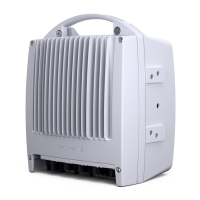MINI-LINKEandEMicro
port is an ordinary serial communication port (RS 232C). The port is available
on every access module unit, and for MINI-LINK E Micro on the radio unit and
Radio Connection Box (RCB). With a PC connected to this port, it is possible to
read and transmit operation and maintenance data w ithin the entire MINI-LINK
network.
6.1.3 Setup of Terminals
In order to have working surveillance, MINI-LINK equipment must be
interconnected through the different communication channels, and each
ter minal within the network must have a unique identity. Each ter minal must
also know the identity of the remote ter m inal and the identities of terminals
connected to its own communication channels. The setup is done by using
MSM. During installation, parameters such as standby mode, frequency
channel number, RF output power and alarm thresholds are set.
6.1.4 Fault Detection
A number of checkpoints are implemented to track a failure down to the faulty
radio unit or units in the access module.
The following lists of t erminal alar ms describe the alarms that are presented
graphically i n the alarm field in the Netman or MSM Terminal window. Alarms
written in bold typeface in the alar m list correspond to buttons in the Terminal
window. These alarms comprise an underlying level shown in normal typeface.
An alarm generates either an A or B-alarm which is presented in Netman, MSM
and on the Local Supervision Interface on the MMU for MINI-LINK E.
96
AE/LZT 110 2012 R8C 2002-03-04

